Living in Michigan and heard some birds but are not sure which ones they were?
Michigan is known for its wildlife, and according to the Michigan Bird Records Committee (MBRC), there are over 450 species of birds there.
Examples of songbirds in Michigan include the American robin, purple martin, tufted titmouse, American goldfinch, yellow warbler, house finch, ovenbird, and many others.
Some of these birds, like the tufted titmouse and the American goldfinch, can be seen year-round in the state, while others, like the American robin, will only spend summer there.
Here are their photos, songs, and some fun facts.
Table of Contents
Songbirds In Michigan
American Robin

- Scientific name: Turdus migratorius
- Lifespan: 2 years
- Wingspan: 12-16 in
- Range In Michigan: Throughout Michigan
The American robin has been the state bird of Michigan since 1931 and is one of the most recognized of all land birds in the state.
These songbirds are commonly found in various habitats ranging from forests to suburbs. Males can be identified by their black heads with yellow beaks and brick-red breasts; females are slightly duller and have brown heads.
American robins can be seen from spring to fall on Michigan’s Upper Peninsula and year-round on the Lower Peninsula.
Their song is described as a “cheery” carol consisting of a string of 10 or so clear whistles; American robins also have a sharp “yeep” alarm call or a mumbled “tuk” when communicating with one another.
Source: G. McGrane, Public domain, via Wikimedia Commons
These birds will also sing when storms approach and when they have passed.
Outside of the breeding season, American robins like to form large flocks of birds, sometimes up to 10,000 individuals!
They are omnivores that feed on invertebrates, especially earthworms, and fruit.
American robins start breeding in Michigan in early spring, from April to July, and produce 2-3 clutches of 3-4 light blue eggs per year.
Purple Martin

- Scientific name: Progne subis
- Lifespan: 5-7 years
- Wingspan:15 in
- Range In Michigan: Throughout Michigan
Purple martins are the largest swallow species in North America. They are common around fields, marshes, farms, and urban areas and are considered a certain sign that spring is coming.
Purple martins can be seen from spring to fall in Michigan. The first to arrive in the state are males, around early April. They will breed there during summer and gather in huge groups before migrating to South America for winter.
They will undertake a 7,000-mile-long journey from the eastern US and Canada to the rainforests of Brazil.
Purple martins can be identified by their forked tails, slightly hooked beaks, and long pointed wings. Males are completely dark purple-blue while females are gray to mottled purple.
Purple martins are very vocal birds.
Their most common songs are chirps, chortles, rattles, and croaks. When fighting over territory, purple martins will make a “hee-hee” sound and a “zwrack” call when interacting with other species.
Source: Jonathon Jongsma, CC BY-SA 3.0, via Wikimedia Commons
They are frequent in areas with martin houses, so make sure to place one if you wish to attract these songbirds.
Males will scout for new or unoccupied houses, but the females are the ones that make the final decision. Pairs typically build their nests out of straw, twigs, and pine needles.
They are very social and colonial birds – the largest roosting colony ever discovered had over 700,000 birds!
Unfortunately, their numbers in Michigan have been declining from the peak of 220 birds in 1979.
Barn Swallow

- Scientific name: Hirundo rustica
- Lifespan: 4 years
- Wingspan: 12.5-13.5 in
- Range In Michigan: Throughout Michigan
Barn swallows are the most widespread swallow species in North America and can be identified by their long forked tails, dark blue upperparts, and orange underparts.
Barn swallows breed in Michigan and can be seen there from spring to fall. The best time to see them in the state would be from May to August.
Barn swallows are common in various habitats; look for them near water.
Listen for their constant “twitter-warble” song during the breeding season that consists of a long series of continuous warbling sounds and rapid, mechanical-sounding “whirrs.”
Source: Record by Justin Wasack as stated on this site: http://www.freesound.org/samplesViewSingle.php?id=74868, CC BY 3.0, via Wikimedia Commons
Males are the first to return to the breeding grounds from Central and South America. They will select their nests and try to attract females with a circling flight and their song.
According to the legend, barn swallows stole fire from the gods and gave it to people. Gods became so angry that they threw a firebrand at the bird, burning its middle tail feathers.
House Finch

- Scientific name: Haemorhous mexicanus
- Lifespan: up to 11 years
- Wingspan: 8-10 in
- Range In Michigan: Lower Peninsula
House finches are widespread songbirds that have conical bills, short wings, and shallowly notched tails.
Males are with streaky red breasts, red eyebrows, foreheads, and rumps, while females are brown above and streaked below; they have no red.
House finches got introduced to Michigan from the western United States and can be now seen throughout the year on the Lower Peninsula.
Listen for the song of males, a long, jumbled warbling that consists of short notes. Their call is a sharp “cheep.”
Source: Jonathon Jongsma, CC BY-SA 3.0, via Wikimedia Commons
Depending on the location, house finches have different “accents” while singing. Californian house finches have two-second songs with 4-26 syllables; the songs of the ones from Wisconsin, Colorado, and Michigan can last longer and contain more syllables.
House finches are gregarious and loud birds; look for them around city parks, urban centers, residential backyards, farms, and forest edges in large flocks.
They are omnivores and feed on seeds, buds, flower parts, berries, small fruits, and occasionally some small insects.
During the non-breeding season, you might also see flocks of house finches around bird feeders. If you want to attract one to your feeder, make sure to add black oil sunflower seeds, millet, and milo.
The red color of the males comes from the berries and fruits in their diet – females prefer to mate with males that have the reddest faces.
Eastern Kingbird
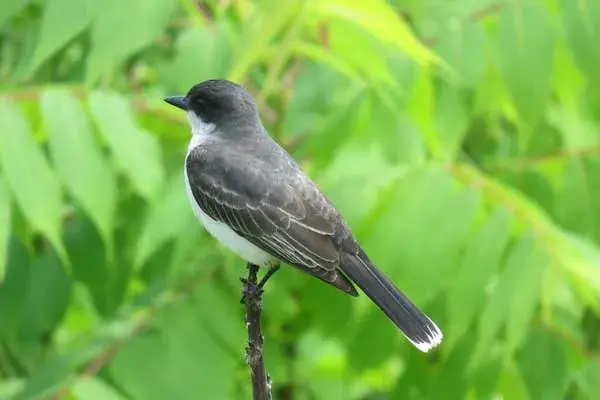
- Scientific name: Tyrannus tyrannus
- Lifespan: up to 11 years
- Wingspan: 13-15 in
- Range In Michigan: Throughout Michigan
Eastern kingbirds are medium-sized songbirds with large heads, upright posture, square-tipped tails, and relatively short beaks. They are easy to identify by their slaty plumage that is white below, a dark cap on their heads, and a white band at the tip of their tails.
Eastern kingbirds can be seen in the open country, farms, and fields of Michigan from spring to fall. Listen for the high-pitched “kit-kit” and “dzee-dzee” calls and their song consisting of high, sputtering notes.
Source: Jonathon Jongsma, CC BY-SA 4.0, via Wikimedia Commons
After spending summer in the state, these Michigan songbirds will migrate to spend winter in South America, primarily northwestern Amazonia.
They will often perch on wires, watch for large insects, and make quick flights to snatch them. Eastern kingbirds also feed on berries and fruit, mainly during winter.
They can be very aggressive and if another bird enters their territory, even a larger one, they will attack fiercely. Neither hawks nor crows are safe from them.
Eastern kingbirds are also one of the many examples of stunning black and white Colorado birds.
House Wren
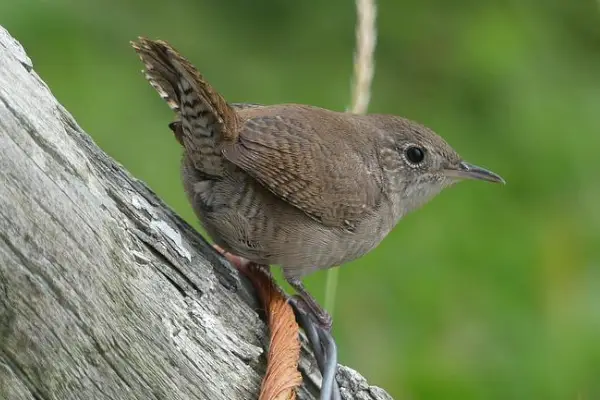
- Scientific name: Troglodytes aedon
- Lifespan: up to 7 years
- Wingspan: 6 in
- Range In Michigan: Throughout Michigan
House wrens are common backyard birds that were named after their tendency to nest around human homes. These small songbirds have flat heads, curved beaks, pinkish or gray legs, and short tails that are usually held cocked.
They are brown above and grayish below with barrings on the wings and tails.
House wrens can be seen from spring to fall in forests, fields, and gardens of Michigan.
They are known for their rush-and-jumble songs. House wrens will often make different harsh sounds: churrs, chatters, rattles, and scolds.
Source: Jonathon Jongsma, CC BY-SA 3.0, via Wikimedia Commons
There are 32 subspecies of house wrens in total.
They might never visit your bird feeder but house wrens might fly through your backyard hunting insects.
If you want to attract house wrens to your yard, all you need to do is to add a birdhouse.
Among other places, these birds are also common in Northern California, Central Florida, and Northeast Ohio.
American Goldfinch
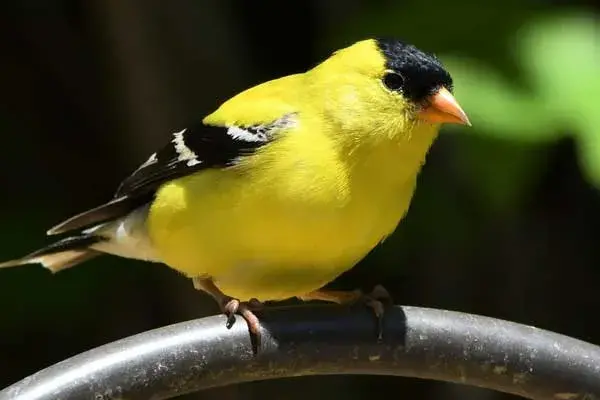
- Scientific name: Spinus tristis
- Lifespan: 3-6 years
- Wingspan: 7.5-8.7 in
- Range In Michigan: Throughout Michigan
American goldfinches are small migratory songbirds that have long wings, small heads, and short, split tails. They are the state birds of Washington, New Jersey, and Iowa.
American goldfinches can be seen throughout the year in Michigan, although some populations might spend only summer in some parts of the Lower and Upper Peninsula.
They can be seen in riparian habitats, around fields, and even garden feeders, where they primarily feed on sunflower seeds and nyjer.
The song of American goldfinches is a long series of musical twitters and warbles while their most common call sounds like they are quietly saying “po-ta-to-chips.”
Source: G McGrane, Public domain, via Wikimedia Commons
They were nicknamed “wild canary” because of their bright yellow plumage.
Males can be identified by their bumblebee pattern when nesting, orange beaks, black foreheads, and white bars over their black wings. During the winter months, they get an olive color while females become dull yellow-brown.
Male and female American goldfinches have colorful carotenoid-based orange bills during the breeding season. The bill serves as an indicator of the overall health of the bird.
The more saturated with orange a bill is, the higher the testosterone levels the bird has.
American goldfinches are herbivores that feed on seeds from many different plants, tree buds, berries, and bird food from feeders. They are also on our list of Northeastern birds.
Black-capped Chickadee

- Scientific name: Poecile atricapillus
- Lifespan: 2-3 years
- Wingspan: 6-8 in
- Range In Michigan: Throughout Michigan
One of the most beloved songbirds of Michigan, black-capped chickadees are small backyard birds with short necks, large heads, black caps and bibs, and gray wings that are edged with white patches.
They can be also identified by their plump build, white cheeks, and buffy flanks.
Black-capped chickadees are common around woodlands, forests, and gardens of Michigan throughout the year. They breed from April to early August and have one clutch of 5-10 white eggs with brownish spots.
As the name suggests, they got their name from the black caps on their heads and the distinctive “chickadee-dee-dee” calls. If you hear more “dee” notes, that means the bird is giving a warning call.
Source: Jonathon Jongsma, CC BY-SA 3.0, via Wikimedia Commons
Black-capped chickadees are the state birds of Massachusetts and Maine in the US and the provincial birds of New Brunswick in Canada.
They are also one of the more useful birds in the orchard or forest as they eat different pests, including insect eggs, larvae, weevils, lice, sawflies, and also some snails, slugs, and spiders.
Pairs are usually monogamous and may remain together for several breeding seasons. In the early spring, the male will even feed the female.
These nonmigratory songbirds might visit your backyard feeder. If you want to enjoy black-capped chickadees’ inquisitive behavior and friendly demeanor, make sure to add sunflower seeds, peanuts, suet, peanut butter, and mealworms to your feeder.
Eastern Phoebe
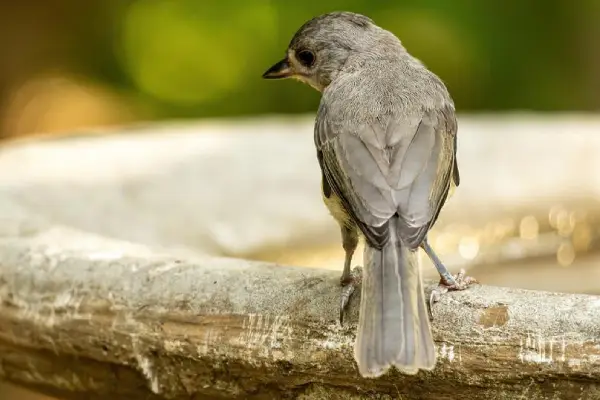
- Scientific name: Sayornis phoebe
- Lifespan: up to 10 years
- Wingspan: 10-11 in
- Range In Michigan: Throughout Michigan
Eastern phoebes are small songbirds with medium-length tails and large heads. They are grayish above, lighter below, and have two buff bars on each wing.
Eastern phoebes can be seen from spring to fall throughout Michigan. They breed from April to July and are common around woods, suburbs, parks, and near water.
Eastern phoebes are members of the flycatcher family and around September/October migrate to winter in southern Gulf Coast states and southernmost Atlantic Coast states.
Listen for the song eastern phoebe got its name from, the two-noted “fee-bee”, and its sharp “chip” call.
Source: G. McGrane, Public domain, via Wikimedia Commons
They like to sit upright and will often pump (wag) their tail after landing.
Eastern phoebe tends to avoid open areas and prefers spots under trees, brushy areas, and overhangs.
These birds will use mud, grass, and moss to build their nests and will attach them to the sides of limestone outcroppings or under rock ledges.
They usually have two broods per year, and each clutch will have from two to six eggs.
Eastern phoebes are omnivores and feed on insects and some fruits.
Tufted Titmouse
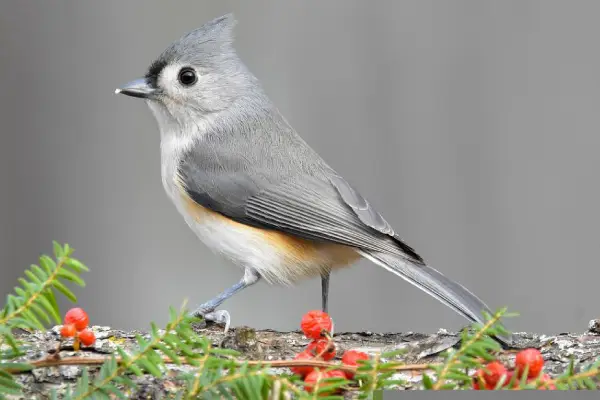
- Scientific name: Baeolophus bicolor
- Lifespan: 2 years
- Wingspan: 8-10 in
- Range In Michigan: Lower Peninsula
Tufted titmice are small gray songbirds with an echoing voice that can be identified by their soft silvery-gray plumage, black eyes, a spot on their foreheads, and heads crested with fawn flanks.
Tufted titmice can be seen year-round in the Lower Peninsula of Michigan, in areas ranging from forests and parks to suburbs. They breed in the state from March to May and lay 5-8 white eggs with brown speckles.
Their song is usually described as a series of 4 to 8 whistled notes that sound like “peter-peter-peter.” The most common call is nasal and mechanical “tsee-day-day-day.”
Source: G. McGrane, Public domain, via Wikimedia Commons
Some estimates claim that there are over 8 million of these birds in existence today.
Tufted titmice are omnivores that mainly feed on berries, nuts, seeds, fruits, and insects. They are common visitors to bird feeders and will first scout a feeder from cover before flying in to grab a seed.
Tufted titmice are cavity nesters that will build their nests in tree holes, nest boxes, or even in old woodpecker nests. If they find snake skin, they might use it as a building material.
Red-eyed Vireo
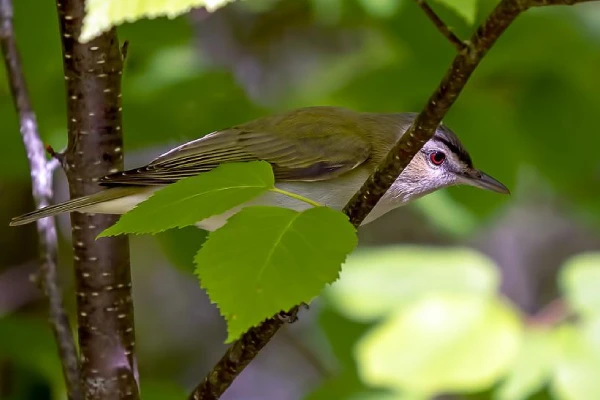
- Scientific name: Vireo olivaceus
- Lifespan: up to 10 years
- Wingspan: 9-10 in
- Range In Michigan: Throughout Michigan
Red-eyed vireos are common songbirds that are olive-green above, dingy below, and have dark eye lines, light eyebrows, heavy beaks, and hard-to-spot red eyes.
These tireless singers will usually sit high up in the trees and emit different sounds – scientists even recorded one red-eyed vireo singing 117 different types of songs!
Source: G. McGrane, Public domain, via Wikimedia Commons
Red-eyed vireos can be seen from spring to fall in Michigan, in the woodlands and gardens of the state. They breed there from around April to August.
The first to arrive at the breeding grounds will be males to establish territories and form pairs shortly after the arrival of the females.
After pairing, females will build the nests (males do not help) and lay a clutch of three to five spotted eggs. Both parents will feed the chicks.
These small songbirds are susceptible to brood parasitism – in one instance, scientists found one red-eyed vireo female incubating four eggs of other birds; there were no vireo eggs in its nest as the other bird had punctured or pitched out the vireo’s eggs.
They are omnivores and usually feed on insects and berries. Males will feed in the high canopy, while females forage lower down.
Red-eyed vireos are very common birds of Northeast Ohio and Western Pennsylvania.
Northern Parula
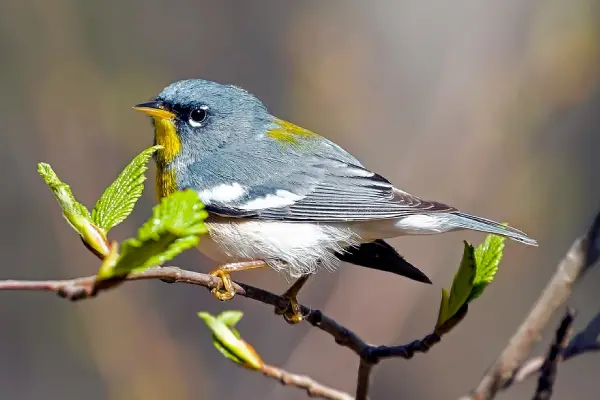
- Scientific name: Setophaga americana
- Lifespan: up to 6 years
- Wingspan: 6-7 in
- Range In Michigan: Upper Peninsula and Northern Michigan
Northern parulas are small birds with short tails and thin, pointy beaks. They are blue-gray above with olive-green backs, yellow underparts, broken white eye arcs, and yellowish beaks and feet.
Northern parulas are acrobatic songbirds that are common during summer in forests and suburbs of the entire Upper Peninsula and northernmost parts of the Lower Peninsula of Michigan.
Northern parulas have two different songs. One is a rising buzzy trill that ends on a sharp note while the second song has distinct pauses in between bouts of the trill. They also emit a sharp “chip” call.
Source: G. McGrane, Public domain, via Wikimedia Commons
Northern parulas are monogamous warblers with rare cases of polygamy. They are omnivores that consume insects, spiders, and some berries.
Black-and-white Warbler

- Scientific name: Mniotilta varia
- Lifespan: up to 11 years
- Wingspan: 7-9 in
- Range In Michigan: Throughout Michigan
Black-and-white warblers are medium-sized warblers and small songbirds that are one of the first to arrive in Michigan in spring.
If you are a beginner birder, these birds are a good choice, as black-and-white warblers are easy to see and recognize.
Their thin and squeaky song is one of the main ways to identify black-and-white warblers.
Listen for a high-pitched “wee-see” song that lasts about three seconds and is repeated around 6 times. Black-and-white warblers also have two calls, a hard “tick” and a soft, thin “fsss.”
Source: G. McGrane, Public domain, via Wikimedia Commons
Black-and-white warblers are common from spring to fall in forests and suburbs of Michigan. They breed in the state from April to August.
The first to arrive will be males that will establish a territory and start searching for a partner. Their courtship rituals include following females around, singing, showing off feathers, and wing fluttering.
They are easy to identify by their fairly long, slightly downcurved beaks and short tails.
You will also notice their black and white striped plumage that is white below. Black-and-white warblers also have black wings with two wide white wing bars.
These birds can be very territorial and aggressive during their breeding season; like all warblers, they’ll attack and fight with other species that enter their territory.
Black-and-white warblers are insectivores (carnivores) that mostly feed on insects, caterpillars, beetles, ants, flies, bugs, and some spiders.
Indigo Bunting
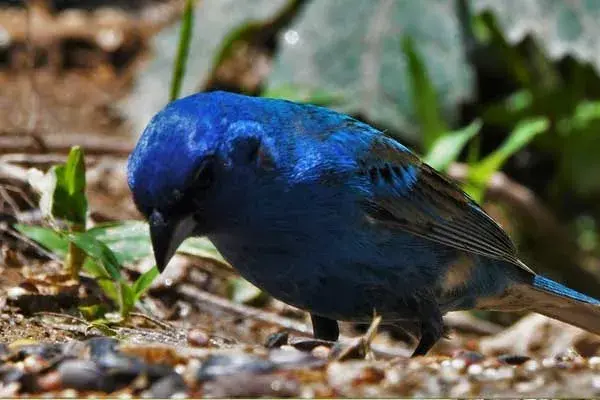
- Scientific name: Passerina cyanea
- Lifespan: 10 years
- Wingspan: 7-9 in
- Range In Michigan: Throughout Michigan
Common around woodlands, forests, parks, and garden feeders, indigo buntings are stocky birds with short conical beaks and short tails.
Males are vivid blue with the most intense color on their heads; females are brown with fine breast streaks.
Indigo buntings breed in Michigan between May and September so the best time to see them there would be from June to August.
Their song is a rapid, excited warble with each note or phrase being given twice.
When marking their territory or attracting females, males will emit a high-pitched song that lasts from two to four seconds and sounds like “sweet-sweet chew-chew.” Both sexes will also use a sharp “chip” alarm call.
Source: G. McGrane, Public domain, via Wikimedia Commons
Indigo buntings are territorial birds and omnivores that feed on insects, seeds, and berries.
Because of their bright blue color, many people consider indigo buntings to symbolize wisdom and spiritual realization.
These birds usually mate for life; occasionally, they may switch partners within a single breeding season.
Yellow Warbler

- Scientific name: Setophaga petechia
- Lifespan: up to 10 years
- Wingspan: 6.3-8.7 in
- Range In Michigan: Throughout Michigan
Yellow warblers are small songbirds that have rounded heads, medium-sized tails, and straight, thin beaks.
Males are yellow with red streaks on breasts while females and immatures are duller and have no streaks.
Yellow warblers can be seen throughout Michigan from spring to fall. They breed in the state from May to June and migrate south to winter from southern California to the Amazon region, Bolivia and Peru.
Their bright and sweet song can be often heard near riparian habitats.
To attract females, male yellow warblers will produce over 3,000 whistling songs per day. Look for males sitting perched near the tops of bushes or trees singing their song that sounds like “sweet-sweet-I’m-so-sweet”.
Source: G. McGrane, Public domain, via Wikimedia Commons
On the other hand, when defending their territories, males will make loud “hissing” calls.
Yellow warblers are diurnal birds and omnivores, feeding on insects such as leafhoppers, beetles, wasps, midges, and caterpillars. During winter, they might also eat some berries and fruits.
These small yellow birds are monogamous and stay together for life. The female will build the nest and incubate 4-5 eggs while the male feeds her. Both parents will take care of the young.
They are susceptible to brood parasitism by brown-headed cowbirds where these small black birds lay their eggs in the warblers’ nests. Since they are too small to get the cowbird eggs out, yellow warblers will simply build a new nest on top of the old one.
American Redstart
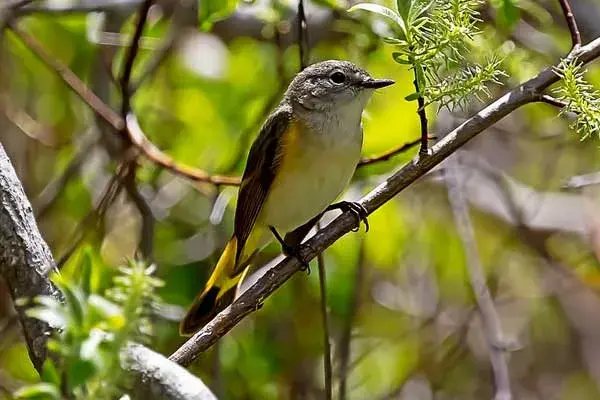
- Scientific name: Setophaga ruticilla
- Lifespan: up to 10 years
- Wingspan: 6.3-9.1 in
- Range In Michigan: Throughout Michigan
These lively warblers have relatively wide, flat beaks and fairly long tails. Males are black with orange flashes on their wings and tails while the females are gray with yellow patches on their tails, wings, and sides.
American redstarts are Michigan songbirds that can be seen in forests and suburbs of the state from spring to fall. The best time to spot them there would be from May to October.
Look for American redstarts in woods and parks and listen for their high-pitched notes that end with an accented phrase. Males and females will also use different calls, including sharp, sweet-sounding “chips” and soft “tsips.”
Source: G. Mcgrane, Public domain, via Wikimedia Commons
They can be often seen hopping among tree branches in search of insects, quickly opening their tails to scare their prey, and then catching them in the air.
These songbirds are mostly monogamous although some males might breed with several females and some females can have offspring that is not fathered by the current partner.
American redstarts have a clutch of two to five eggs and can be attracted to your backyard with berry plants such as magnolia and serviceberry.
Read More: Examples of incredible yellow and green birds
Scarlet Tanager
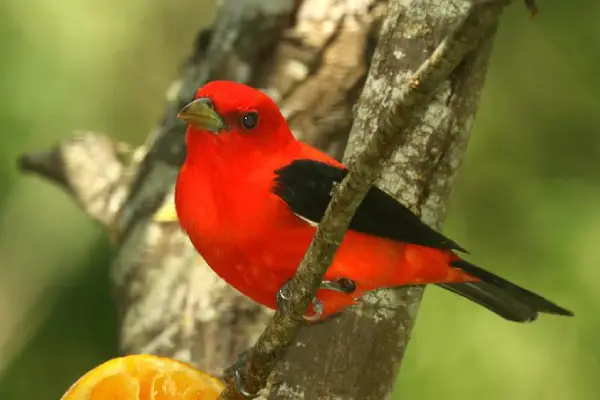
- Scientific name: Piranga olivacea
- Lifespan: up to 11 years
- Wingspan: 10-12 in
- Range In Michigan: Throughout Michigan
Scarlet tanagers are medium-sized songbirds with thick, rounded beaks, fairly large heads, and short and broad tails.
Males are unmistakable with their bright red plumage, black wings and tails, bone-gray beaks, and black eyes. Females are lime to yellow-green and have white wing linings and gray flanks.
Scarlet tanagers are common from spring to fall around forests and gardens of Michigan. They leave the state around September/October and migrate to winter in northwestern South America.
Listen to the males singing a series of 4-5 chirruping phrases with a hurried quality. Females will sing more softly. People often compare scarlet tanagers’ song to one of a robin with a sore throat. The call is a distinctive “chip-burr.”
Source: G. McGrane, Public domain, via Wikimedia Commons
Scarlet tanagers forage high in trees and primarily feed on insects and some fruit.
First to arrive at their breeding grounds are males, followed by females a week later. The pair will have a clutch of around 4 light blue eggs with a green tinge.
Chipping Sparrow
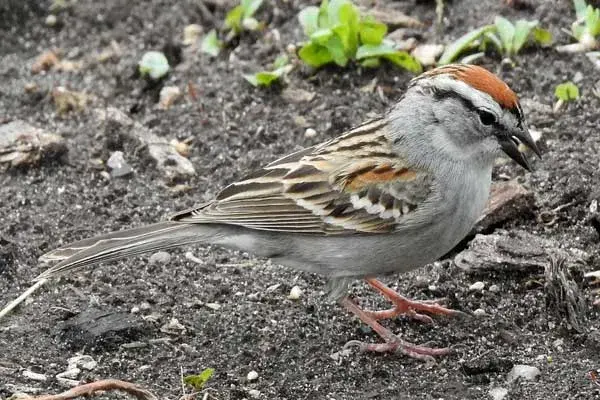
- Scientific name: Spizella passerina
- Lifespan: up to 9 years
- Wingspan: 8-9 in
- Range In Michigan: Throughout Michigan
Chipping sparrows are small songbirds commonly found in forests and fields of Michigan. They can be seen there from spring to fall.
Listen for the song of male chipping sparrows, a long, dry trill of evenly spaced, almost mechanical-sounding chips. To communicate with others, they will emit a single “chip” call. Their alarm call is a long “zeee.”
Source: G. McGrane, Public domain, via Wikimedia Commons
Chipping sparrows have dusky eyebrows and dark eye-lines; during the breeding season, the lines above each eye become nearly white.
These delicate and active red-headed sparrows also have slightly notched tails and during the breeding season, they have a distinctive bright chestnut crown.
There are two subspecies, the eastern and the western chipping sparrows.
Eastern Bluebird
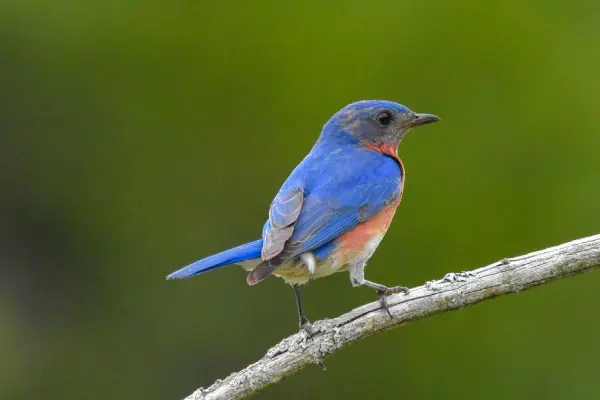
- Scientific name: Sialia sialis
- Lifespan: 6-10 years
- Wingspan: 9-12 in
- Range In Michigan: Throughout Michigan
These small songbirds have big, rounded heads, large eyes, and alert posture. Males are bright blue above and white below, with orange throats and breasts. Females are duller.
Eastern bluebirds can be seen from spring to fall in Michigan, in habitats ranging from forests to gardens. In some southern counties of Michigan, these songbirds can be even seen year-round.
Migratory eastern bluebirds will scout for nesting sites from February to early March in the state.
To attract a female, a male bluebird will sing over 1,000 songs per hour; it sings without opening its beak wide. The song of the eastern bluebirds is a soft melodious warble while their call is a liquid and musical “turee” or “queedle.”
Source: Jonathon Jongsma, CC BY-SA 3.0, via Wikimedia Commons
They are cavity nesters that love nest boxes and very social birds that can live in flocks with over 100 individuals.
Eastern bluebirds are omnivores that mostly feed on insects, including grasshoppers, crickets, beetles, caterpillars, and some fruit.
These small blue and orange birds are the official birds of Missouri and New York.
Read More: 25 stunning birds found in New York
Ovenbird
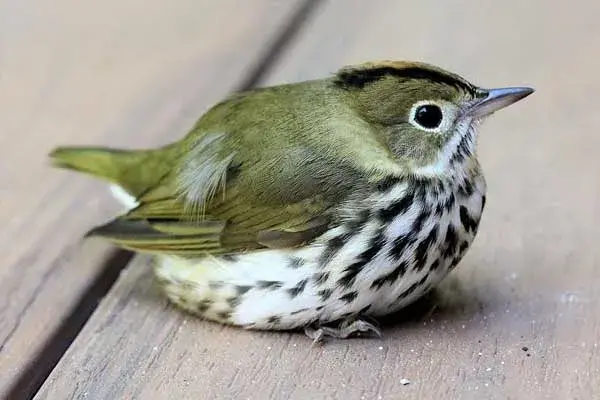
- Scientific name: Seiurus aurocapilla
- Lifespan: up to 11 years
- Wingspan: 7.5–10.2 in
- Range In Michigan: Throughout Michigan
These small migratory songbirds can be identified by their olive-green upperparts, black and white underparts, white rings around the eyes, and the black stripe below the cheeks. They also have dark eyes, a dark upper part of a thin pointed beak, a horn-colored lower part, and pinkish legs and feet.
Ovenbirds can be seen in Michigan from spring to fall, often skulking in the forest understory.
Lister for their territorial rapid, resounding “tea-cher, tea-cher” song consisting of 8-13 phrases. Ovenbirds also have several short calls, including the “ple-bleep,” “whink,” and high “tsip.”
Source: G McGrane, Public domain, via Wikimedia Commons
They can be also recognized by walking instead of hopping.
Ovenbirds got their name from the nest they build called the “oven” – it is a dome-like structure placed on the ground with a side entrance that makes it resemble a Dutch oven.
When a predator is nearby the nest, the female can perform a distraction display and simulate a crippled bird.
Gray Catbird
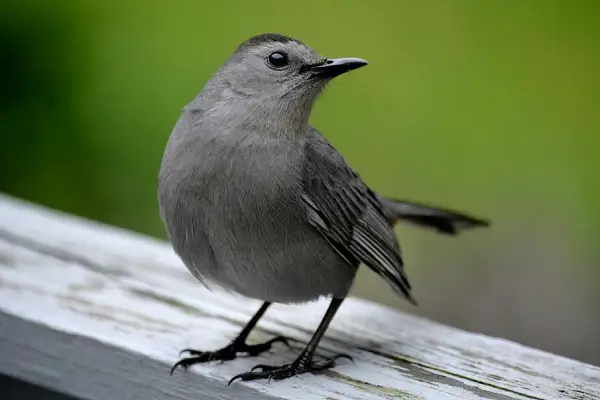
- Scientific name: Dumetella carolinensis
- Lifespan: up to 17 years
- Wingspan: 8.7-11.8 in
- Range In Michigan: Throughout Michigan
Gray catbirds are medium-sized songbirds with gray plumage, black caps, beaks, legs, tails, and rufous undertails.
Gray catbirds can be seen from spring to fall in Michigan, in habitats ranging from forests to gardens. They breed somewhere between April and August in the state.
They are unmistakable for their cat-like call after which they got their name.
Gray catbirds are related to mockingbirds and have excellent singing abilities.
They have a song that consists of a long, irregular succession of musical and mechanical notes and phrases. They will often copy the songs of other birds and mix them to make a new one.
Source: G. McGrane, Public domain, via Wikimedia Commons
Unlike mockingbirds that sing perched on trees, catbirds will often sing from inside a bush or small tree while being hidden by the vegetation.
You might be able to attract them by “pishing” sounds.
These fearless birds are not scared of invaders and will often attack and peck predators that come close to their nests. Gray catbirds will also destroy brood parasitic eggs laid in their nests.
These songbirds are omnivores and feed on insects and berries.
Eastern Towhee
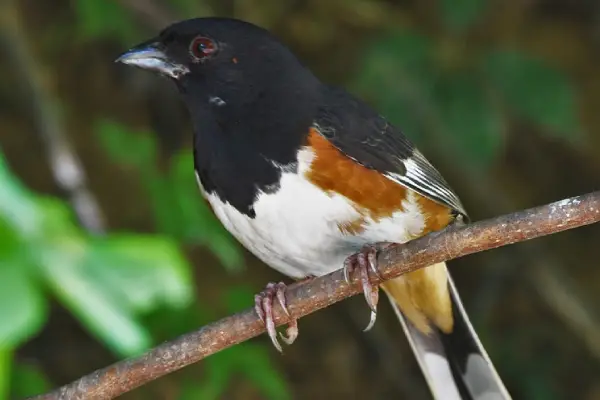
- Scientific name: Pipilo erythrophthalmus
- Lifespan: up to 12 years
- Wingspan: 8-12 in
- Range In Michigan: Throughout Michigan
Eastern towhees are large and conspicuous sparrows that are black above, white below, and have rufous flanks, red eyes, and white wing stripes. Females are similar to males, only brown instead of black.
Eastern towhees can be seen in the woods and gardens of Michigan from spring to fall. They might be hard to spot as they love to stay in thick undergrowth but once you learn their song, you will recognize them with ease.
Eastern towhees are famous for their short, three-note “drink-your-tea-ee-ee” song that ends in a higher-pitched trill. They also have a sharp, loud “che-wink” or “tow-whee” call.
Source: Eastern Towhee, Public domain, via Wikimedia Commons
Eastern towhees are secretive birds that spend most of the time on the ground, foraging through leaves using both feet.
These songbirds nest on or close to the ground, usually under bushes or in brush piles. They will have two broods per year with 2-6 eggs. The species is monogamous.
Eastern towhees are omnivores and their diet mainly consists of seeds, fruits, spiders, and insects.
Rose-breasted Grosbeak

- Scientific name: Pheucticus ludovicianus
- Lifespan: up to 24 years in captivity
- Wingspan: 11-13 in
- Range In Michigan: Throughout Michigan
Rose-breasted grosbeak is a medium-sized songbird that has a large triangular beak, a stocky body, a short neck, and a squared tail. Males are black above, white below, have rose-red upper breasts and underwings, and white spots on wings and tail tips. Females are brown and streaky.
Rose-breasted grosbeaks are commonly found in forests and gardens of Michigan from spring to fall. The best time to see them in the state is from May to September as they winter in Central and South America.
Rose-breasted grosbeaks have a song that is a subdued mellow warbling, resembling a sweeter version of the song of the American robin. They also have a sharp “pink” call that resembles a woodpecker’s call.
Source: G. McGrane, Public domain, via Wikimedia Commons
Rose-breasted grosbeaks forage in shrubs and trees looking for insects, seeds, and berries.
Attract them to your bird feeder by adding sunflower seeds, safflower seeds, and raw peanuts.
Read More: 5 examples of incredible pink birds found in Florida
Evening Grosbeak
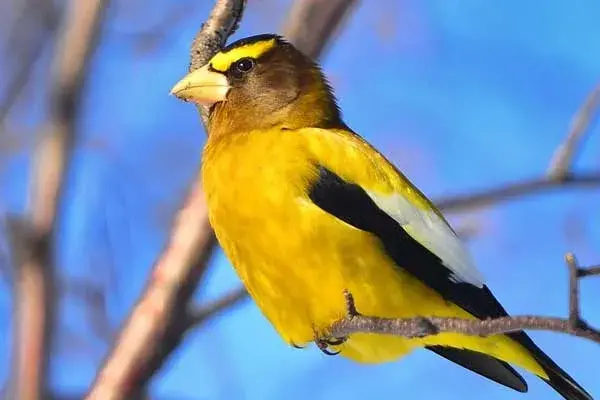
- Scientific name: Coccothraustes vespertinus
- Lifespan: 15-16 years
- Wingspan: 12-14 in
- Range In Michigan: Throughout Michigan
Evening grosbeaks are large finches with prominent bright yellow eyebrows. They can be identified by their yellow upperparts, black crowns, wings, and tails, and large white wing patches.
Evening grosbeaks can be seen year-round in the Upper Peninsula and during winter in the Lower Peninsula of Michigan. Listen for their song which consists of a series of short, musical whistles.
Source: Jonathon Jongsma, CC BY-SA 3.0, via Wikimedia Commons
These stocky songbirds have thick beaks and necks, full chests, and relatively short tails.
Evening grosbeaks are very fast eaters that can devour almost 100 seeds in five minutes, so make sure to add sunflower seeds to your bird feeder, if you wish to attract them.
They are omnivores that also feed on insects and berries.
Read More: 15 largest birds in Michigan
Bobolink

- Scientific name: Dolichonyx oryzivorus
- Lifespan: 2-9 years in the wild
- Wingspan: 10.6 in
- Range In Michigan: Throughout Michigan
Bobolinks are small black songbirds with yellow heads. Males are black with buffy napes, scalloped backs, white shoulders, and rumps. Females are straw-colored with striped crowns and backs.
Bobolinks are common around the grass and hay fields of Michigan from spring to fall. Males have a song that consists of 25-50 notes that are given when flying and is a mixture of sharp high notes and buzzy low pitches.
They weigh from one to two ounces and have a wingspan of around 10.6 in.
People often call them “rice birds” for their tendency to feed on cultivated grains during winter. Bobolinks are omnivores whose diet mostly consists of seeds and insects.
These long-distance migrants travel over 12,000 miles to and from central South America each year – during a lifetime, one bobolink may travel the same distance as four or five laps around the planet.
Bobolinks are polygynous but also often polyandrous. This means that each clutch of eggs laid by a single female may have multiple fathers.
A group of bobolinks is known as a “chain”.
Read More: List of smallest birds in Michigan
Summary
This concludes our list of songbirds in Michigan.
There are plenty of these in the state, from house wrens and scarlet tanagers to American redstarts and yellow warblers.
Next time you see or hear any of these birds in person, you should be able to recognize them with ease!
And if you enjoyed our article, explore our other popular reads on North American songbirds: